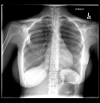A Fractured Tracheostomy Tube Causing Airway Compromise
- PMID: 35591761
- PMCID: PMC9128454
- DOI: 10.12659/AJCR.936072
A Fractured Tracheostomy Tube Causing Airway Compromise
Abstract
BACKGROUND A wide variety of emergency scenarios associated with tracheostomy tubes have been reported in patients with complex airway disease. Fracture of a tracheostomy tube is a rare complication with a potential for catastrophic outcome. The aim of this case report is to present clinical features and management of airway compromise due to a fractured tracheostomy tube in a patient with subglottic and tracheal stenosis. CASE REPORT A 19-year-old woman with a history of chronic lung disease, developmental delay, subglottic stenosis, and tracheal stenosis presented to the Emergency Department after her mother noticed that the tracheostomy tube was broken at the junction of the cannula and neck plate. Upon arrival, the patient was stable and the stoma site had a pinpoint-size opening. A chest X-ray revealed a dislodged tracheostomy tube with the shaft's convexity ventrally oriented in the trachea. The stoma was dilated to allow passage of a 2.5-mm flexible laryngoscope into the trachea. The fractured tracheostomy tube lodged in the trachea distal to the stoma and proximal to the carina. The fractured tracheostomy tube migrated to the suprastomal site at the time of repeat tracheoscopy under general anesthesia. The fractured tracheostomy tube was removed transorally through the tracheal and subglottic stenosis with the use of optical forceps and rigid bronchoscope. CONCLUSIONS Prompt recognition and management of a fractured tracheostomy tube is critical to prevent morbidity and mortality. Caregivers and healthcare providers must be prudent about proper tracheostomy tube care, potential manufacturing defects, and monitoring the condition of tracheostomy tubes.
Conflict of interest statement
Figures
References
-
- Mitchell RB, Hussey HM, Setzen G, et al. Clinical consensus statement: Tracheostomy care. Otolaryngol Head Neck Surg. 2013;148(1):6–20. - PubMed
-
- Bassoe HH, Boe J. Broken tracheotomy tube as a foreign body. Lancet. 1960;1:1006–7. - PubMed
-
- Otto RA, Davis W. Tracheostomy tube fracture: An unusual etiology of upper respiratory airway obstruction. Laryngoscope. 1985;95(8):980–81. - PubMed
-
- Gupta SC. Fractured tracheostomy tubes in the tracheo-bronchial tree: (A report of nine cases) J Laryngol Otol. 1987;101(8):861–67. - PubMed
-
- Gana PN, Takwoingi YM. Fractured tracheostomy tubes in the tracheobronchial tree of a child. Int J Pediatr Otorhinolaryngol. 2000;53(1):45–48. - PubMed
Publication types
MeSH terms
LinkOut - more resources
Full Text Sources




